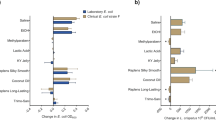Summary
Various factors contribute to the formation of malodor in intravaginal collagen sponges (CS) worn for several days by sexually active persons. To study this problem we developed an in vitro model: CS was infiltrated with semen and incubated at various pH's or in the presence of various drugs, at 37° and 95% O2-5% CO2 in humid atmosphere. The odor was measured by subjective olfactometry as well as quantitated and characterized by gas liquid chromatography. Based on previous findings concerning the disappearance of polyamines from the semen in sponges with malodor and present detection of maximal malodor formation at pH 7.4 and absence of malodor with heat-inactivated semen we propose that malodor forms through the enzymatic oxidation of polyamines or diamines possibly by diamine oxidase (DAO) of the semen. Direct assay of DAO showed that all factors inhibiting or stimulating the malodor affected the activity of DAO in the same direction. Thus, while copper ions were stimulatory to odor and DAO activity, zinc ions, acid environment (3.4 pH), exogenous spermine administration, isoproniazid and pargyline, both known inhibitors of MAO's and DAO's, reduced malodor and DAO activity.
We found that more intensive malodor developed in sponges made of polyurethane, cellulose or spongin (sea sponge) than of collagen.
Whole semen caused greater malodor formation than prostatic fluid and seminal plasma. Both washed spermatozoa and vaginal secretion did not induce any subjectively detectable offensive odor in sponges. Addition of a mixture of nonpathogenic microorganisms to the semen did not enhance the formation of subjectively detectable malodor. GLC showed characteristic differences between volatile compounds formed by ejaculate and bacteria. While most of the malodor formed by the semen-CS system was enzymatically related, some evidence indicates a portion of malodor to be nonenzymatic process.
It is concluded that the most feasible method preventing the semen related vaginal malodor is to keep the CS acidic (pH 5) and to impregnate sponges with low concentrations of zinc sulfate (40 mg/sponge), unless the sponge is removed 24 h after the intercourse, washed and reinserted.
Similar content being viewed by others
References
Chvapil, M.: Process for the production of collagen fiber fabrics in the form of felt-like membranes or sponge-like layers. US patent 3,823,212
Chvapil, M., Chvapil, T., Jacobs, S. et al.: Laboratory and clinical testing of an intravaginal contraceptive collagen sponge. Contraception15, 693–703 (1977)
Chvapil, M., Chvapil, T. A., Owen, J. A. et al.: Reaction of vaginal tissue of rabbit and of cheek pouch of hamster to inserted collagen sponges treated either with zinc or copper. Amer. J. Obstet. Gynec.130, 63–70 (1978)
Chvapil, M., Eskelson, C., Jacobs, S. et al.: Studies on vaginal malodor. I. Study in humans. Obstet. and Gynec. (in press)
Chvapil, M., Heine, M. W., Horton, H.: The acceptance of the collagen sponge diaphragm as an intravaginal contraceptive in human volunteers. Fertil. and Steril.27, 1398–1406 (1976)
Chvapil, M., Stankova, L., Zukoski, C., IV. et al.: Inhibition of some functions of polymorphonuclear leukocytes by in vitro zinc. J. Lab. clin. Med.89, 135–146 (1977)
Cohen, L.: Influence of pH on vaginal discharges. Brit. J. vener. Dis.45, 241–246 (1969)
Crabbe, M. J. C., Waight, R. D., Bardsley, W. G. et al.: Human placental diamine oxidase improved purification and characterization of a copper- and manganese-containing amine oxidase with novel substrate specificity. Biochem. J.155, 679–687 (1976)
Eyer, H., Rohrmann, A., Tech, G.: The problem of deodorization in intimate hygiene. Med. Klin.56, 1277–1280 (1961)
Ho, B. T.: Monoamine oxidase inhibitors. J. pharm. Sci.61, 821–837 (1972)
Holtta, E., Pulkkinen, P., Elfving, K. et al.: Oxidation of polyamines by diamine oxidase from human seminal plasma. Biochem. J.145, 373–378 (1975)
Inouye, M., Pardee, A. B.: A requirement of polyamines for bacterial division. In: Annals of the New York Academy of Sciences, vol. 171, pp. 901–909. Metabolism and biological functions of polyamines (Herbst, E. J., ed.) Uriel Bachrach 1970
Janne, J., Holtta, E., Haaranen, P. et al.: Polyamines and polyamine-metabolizing enzyme activities in human semen. Clin. chim. Acta48, 393–401 (1973)
Katz, S. H., Talbert, E. J.: US Department Commerce Bureau of Mines Technical Paper, p. 480 (1930)
Levy, B. J., Fair, W. R.: The location of antibacterial activity in the rat prostatic secretions. Invest. Urol.11, 173–177 (1973)
Lindstrom, A., Petterson, G.: The mechanism of inhibition of pig-plasma benzylamine oxidase by the copper-chelating reagent cuprizone. Europ. J. Biochem.48, 229–236 (1974)
Lowicki, N., Sidillo, M., Neunhoeffer, O.: Desodorierung mit Grillocin. Kosmetika1, 47–51 (1973)
Lowicki, N., Sidillo, M., Neunhoeffer, O.: Desodorierung mit Grillocin. Kosmetika2, 14–17 (1974)
Mishell, D. R., Lumkin, M.: Initial clinical studies of intravaginal rings containing norethindrone and norgestrel. Contraception12, 253–260 (1975)
Tipton, K. F.: A sensitive fluorometric assay for monoamine oxidase. Analyt. Biochem.28, 318–325 (1969)
Zeller, E. A.: Diamine oxidase: specificity and mechanism. In: Advances in Biochemical Psychopharmacology, Vol. 5, pp. 167–180. New York: Raven Press 1972
Zeller, E. A., Joel, C. A.: Beiträge zur Fermentchemie des männlichen Geschlechtsapparates. 2. Mitteilung. Über das Vorkommen der Cholinesterase, der Mono- und Diaminoxydase in Sperma und Prostata und über die Beeinflussung der Spermen-Beweglichkeit durch Fermentinhibitoren. Helv. chim. Acta24, 968–976 (1941)
Author information
Authors and Affiliations
Additional information
Supported in part by a contract from the Program for Applied Research on Fertility Regulation, Northwestern University (PARFR-85N) under Prime Contract AID/csd-3608; a grant from Medi-Coll, Inc., Phoenix, Arizona
Rights and permissions
About this article
Cite this article
Chvapil, M., Chvapil, T. & Eskelson, C. Studies on vaginal malodor. Arch. Gynak. 225, 77–89 (1978). https://doi.org/10.1007/BF00670844
Received:
Issue Date:
DOI: https://doi.org/10.1007/BF00670844




